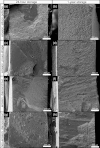Long-term bonding to eroded dentin requires superficial bur preparation
- PMID: 22146968
- PMCID: PMC3443345
- DOI: 10.1007/s00784-011-0650-8
Long-term bonding to eroded dentin requires superficial bur preparation
Abstract
Objectives: This study aims to evaluate the influence of different surface preparation techniques on long-term bonding effectiveness to eroded dentin.
Materials and methods: Dentin specimens were eroded by pH cycling or were left untreated as control, respectively. Five different "preparation" techniques were applied: (1) cleaning with pumice, (2) air abrasion, (3) silicon polisher, (4) proxo-shape, and (5) diamond bur. The three-step etch-and-rinse adhesive OptiBond FL (O-FL; Kerr) and the mild two-step self-etch adhesive Clearfil SE Bond (C-SE; Kuraray) were evaluated. Micro-tensile bond strength was measured after water storage for 24 h and 1 year. Fracture analysis was performed by stereomicroscopy and SEM. Interfaces were characterized by TEM. Differences were statistically analyzed with a linear mixed effects model (α = 0.05).
Results: Erosion reduced bond strength in all groups, but this effect was less prominent when eroded dentin was prepared by diamond bur. Storage lowered bond strength in almost all groups significantly, but this ageing effect was more prominent for the eroded surfaces than for non-eroded controls. Whereas after 1-year control specimens revealed superior bond strength with the three-step etch-and-rinse adhesive (O-FL), the mild two-step self-etch adhesive (C-SE) revealed a better 1-year bond strength to eroded dentin. The interface at eroded dentin appeared very prone to degradation as was shown by the increased amount of adhesive failures and by the silver infiltration detected by TEM.
Conclusions and clinical relevance: Although a minimally invasive approach should clinically always be strived for, superficial preparation (or minimal roughening) with a diamond bur is recommendable for long-term bonding to eroded dentin.
Figures





